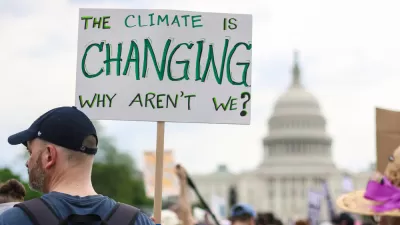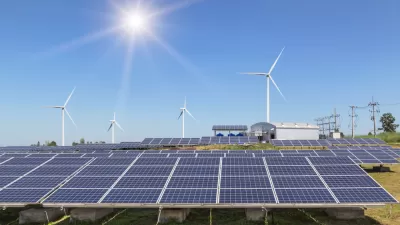2021 greenhouse gas emissions from U.S. transportation increased 10 percent compared to the previous year, pushing the entire world further from the emissions reductions necessary to prevent the worst effects of climate change.

U.S. greenhouse gas emissions increased 6.2 percent compared to 2020 but still remain 5 percent lower than 2019, according to an analysis published today by Rhodium Group based on preliminary data for 2021.
According to the report, U.S. climate emissions are increasing faster that the economy—preliminary economic data estimates that year-on-year GDP grew by 5.7 percent in 2021. The report pins the blame for the rising emission totals on coal-fired power generation, which increased by 17 percent, and a 10 percent of increase from transportation.
Alfredo Rivera, Kate Larsen, Hannah Pitt, and Shweta Movalia summarize the key findings of the report in a note written for the Rhodium Group website:
The transportation and electric power sectors experienced the steepest rise in emissions relative to 2020—10% and 6.6%, respectively—both claiming back about two-thirds of the drop from 2019 levels (Figure 2). Industry, which saw the most modest drop in emissions in 2020 at 6.2%, rebounded 3.6% in 2021—making up just over half the difference from 2019 levels. Buildings saw the smallest rise in GHG emissions in 2021, growing only 1.9% from 2020, returning only a quarter of the drop in emissions from 2020.
The article also breaks down the emissions increases for the transportation sector:
Despite hopes that life would get back to normal in 2021, passenger travel never fully recovered to 2019 levels. After falling 13% in 2020, gasoline demand—indicative of demand for on-road passenger travel—rose steadily through 2021, ending the year 10% above 2020 levels. Despite air travel’s dramatic surge in 2021 (rising 26%), it remained down 24% below 2019 levels. Road freight was the only transport mode that rebounded beyond 2019 levels in 2021. Continued demand for consumer goods kept freight demand high, even surpassing 2019 levels for several months of the year. On a year-on-year basis, aggregate diesel demand rose 9% from 2020 levels, putting it at 0.4% above 2019 levels.
The transportation sector's rebounding carbon emissions once again reveal the deeply ingrained role fossil fuels are in the economy. Even with millions of Americans taking their cars off the roads while working from home, sprawling development patterns, the separation of uses, and the lack of alternative transportation infrastructure ensures that any economic increase will ride on the back of combustions engines.
The Washington Post and the Boston Globe picked up news of the report, both focusing on the news in context of the Biden administration's goals to cut the nation's emissions in half by 2030, but the consequences of the country's backsliding on carbon emissions are far broader than a political agenda. According to the Sixth Assessment Report, published by the U.N.'s International Panel on Climate Change in August 2021, the world has a greenhouse has budget of 500 gigatons of carbon dioxide –about what humans produce every ten years—to keep the warming of the planet below 1.5 degrees Celsius by the end of the century.
The source article provides more detail about the coal sector's resurgence in the past year, resulting from increased prices from natural gas, as well as how the year's results impact the country's commitment to the Paris Climate Agreement.
FULL STORY: Preliminary US Greenhouse Gas Emissions Estimates for 2021

Alabama: Trump Terminates Settlements for Black Communities Harmed By Raw Sewage
Trump deemed the landmark civil rights agreement “illegal DEI and environmental justice policy.”

Study: Maui’s Plan to Convert Vacation Rentals to Long-Term Housing Could Cause Nearly $1 Billion Economic Loss
The plan would reduce visitor accommodation by 25% resulting in 1,900 jobs lost.

Planetizen Federal Action Tracker
A weekly monitor of how Trump’s orders and actions are impacting planners and planning in America.

Wind Energy on the Rise Despite Federal Policy Reversal
The Trump administration is revoking federal support for renewable energy, but demand for new projects continues unabated.

Passengers Flock to Caltrain After Electrification
The new electric trains are running faster and more reliably, leading to strong ridership growth on the Bay Area rail system.

Texas Churches Rally Behind ‘Yes in God’s Back Yard’ Legislation
Religious leaders want the state to reduce zoning regulations to streamline leasing church-owned land to housing developers.
Urban Design for Planners 1: Software Tools
This six-course series explores essential urban design concepts using open source software and equips planners with the tools they need to participate fully in the urban design process.
Planning for Universal Design
Learn the tools for implementing Universal Design in planning regulations.
Caltrans
Smith Gee Studio
Institute for Housing and Urban Development Studies (IHS)
City of Grandview
Harvard GSD Executive Education
Toledo-Lucas County Plan Commissions
Salt Lake City
NYU Wagner Graduate School of Public Service





























